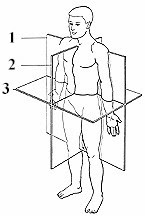Fitness Tips Article Series, 5
For the final part (5) of this series, I will discuss what it means to functionally train your body. Functional training is basically training your body for how you want to live and play. For example, an athlete will train differently from someone who just wants to maintain general fitness.
What does it mean to weight train in all three planes of motion? It is important to remember that although an activity might be one-plane dominant (running straight ahead is sagittal plane dominate), the other two planes of motion must be stable in order to perform the activity efficiently. Also, no motion occurs in one plane only. The three planes are explained below:

1. Frontal Plane – imaginary bisector that divides the body into equal front and back halves. The motions primarily involve abduction and adduction (side-to-side motions). Abduction takes a limb away from the midline of the body and adduction takes the limb closer to the midline of the body.
Examples include exercises performed on a hip abductor and hip adductor machines. Other frontal plane motions would be side lunges, dumbbell lateral shoulder raises and lateral spinal flexion. Quickness and agility movements made by athletes require adequate frontal plane stability, strength, power, flexibility and balance.
2. Sagittal Plane – imaginary bisector that divides the body into left and right halves. The motions involve forward-backward and up-down movements relative to the body and/or joint. Examples would be walking, running, bicep curls, leg curls and seated back rows.
Traditional training techniques (such as training with machine weights) have focused on the sagittal plane of motion. This is not an effective training technique if the other planes of motion are ignored during training.
3. Transverse Plane – imaginary bisector that divides the body into top and bottom halves. The motions are primarily rotational. Obviously, this will be a dominate plane of motion for many athletes and everyone in general.
Baseball players (swinging, turning, pivoting, etc.), football defensive backs (hip rotations, quick turns, etc.) are just two examples. Transverse lunges and many medicine ball exercises will train you in the transverse plane.
Part of functional training involves doing exercises that train all three planes of motion. You will have to get off of the weight machines and diversify your training methods! Your body will thank you!
Be sure and download your Free Dumbbell and Medicine Ball Metabolic Fat Burner Workouts and start shaping your body faster!
Mark Dilworth, BA, PES
Your Fitness University
My Fitness Hut
Her Fitness Hut
Sports Fitness Hut
What does it mean to weight train in all three planes of motion? It is important to remember that although an activity might be one-plane dominant (running straight ahead is sagittal plane dominate), the other two planes of motion must be stable in order to perform the activity efficiently. Also, no motion occurs in one plane only. The three planes are explained below:

1. Frontal Plane – imaginary bisector that divides the body into equal front and back halves. The motions primarily involve abduction and adduction (side-to-side motions). Abduction takes a limb away from the midline of the body and adduction takes the limb closer to the midline of the body.
Examples include exercises performed on a hip abductor and hip adductor machines. Other frontal plane motions would be side lunges, dumbbell lateral shoulder raises and lateral spinal flexion. Quickness and agility movements made by athletes require adequate frontal plane stability, strength, power, flexibility and balance.
2. Sagittal Plane – imaginary bisector that divides the body into left and right halves. The motions involve forward-backward and up-down movements relative to the body and/or joint. Examples would be walking, running, bicep curls, leg curls and seated back rows.
Traditional training techniques (such as training with machine weights) have focused on the sagittal plane of motion. This is not an effective training technique if the other planes of motion are ignored during training.
3. Transverse Plane – imaginary bisector that divides the body into top and bottom halves. The motions are primarily rotational. Obviously, this will be a dominate plane of motion for many athletes and everyone in general.
Baseball players (swinging, turning, pivoting, etc.), football defensive backs (hip rotations, quick turns, etc.) are just two examples. Transverse lunges and many medicine ball exercises will train you in the transverse plane.
Part of functional training involves doing exercises that train all three planes of motion. You will have to get off of the weight machines and diversify your training methods! Your body will thank you!
Be sure and download your Free Dumbbell and Medicine Ball Metabolic Fat Burner Workouts and start shaping your body faster!
Mark Dilworth, BA, PES
Your Fitness University
My Fitness Hut
Her Fitness Hut
Sports Fitness Hut






Comments
Post a Comment